- Vincenzo Guerra (1840-1870)
- Regina Guerra (1870-1887)
- Gregorio Gregorj (1887-1913)
- Giorgio Gregorj (1913-1924)
- Alfredo Gregorj (1924-1965)
The Fornace Guerra-Gregorj represents a place with a strong historical and artistic value that has characterized the Veneto since 1840 until the recent 1960s.
The Guerra-Gregorj furnace, which contains the culture and history of an ancient and magical place, influences our daily life through its magnificent ceramic friezes. The façade of the Mezzà, for example, features friezes attributed to Arturo Martini and Alberto Martini.
The factory has received multiple recognitions and honours, including being awarded the Silver Medal at the 1900 Paris Universal Exhibition.
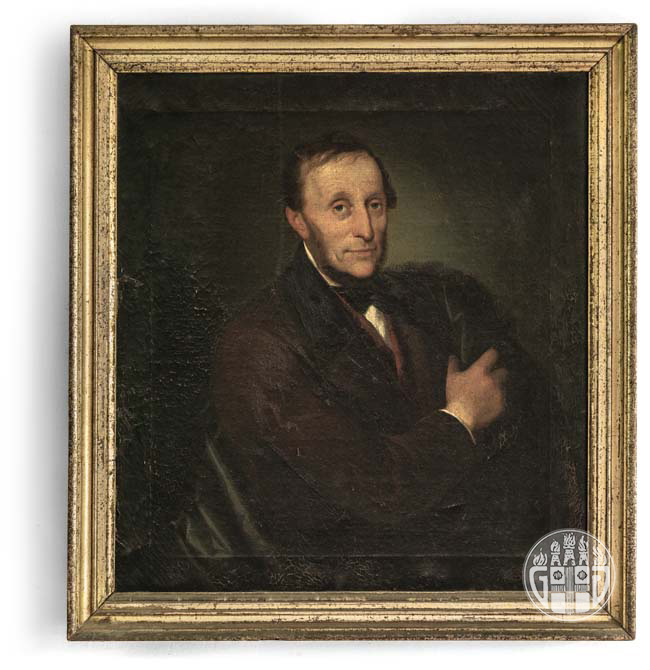
Vincenzo Guerra
In front of an existing building, a residual part of an ancient villa called "Mezzà" (in Venetian dialect: mezzanine, office) which Vincenzo Guerra, a nobleman of Friulian origins but born in Casier in 1791, had built in 1840, a plant industrial area around which various buildings arose including the carpentry shop, the vase workshop, the ceramic kiln and small terracotta statues workshop, the Artists' Hall, the brickworks and the granaries. The entire area measures approximately twenty-one thousand square meters. The industrial plant specialized in the manufacture of bricks and other building elements in particular.
Vincenzo Guerra administered wisely, also enlarging his possessions which were necessary for the extraction of clay and dedicating himself especially to construction and restoration materials, bricks, logs, fireplaces, terracotta floors and frames.

Regina Guerra
Vincenzo Guerra was soon joined in the management by his daughter Regina, the only child he had with his wife Elisabetta Paradisi. She had married Bartolomeo Gregorj but was soon widowed. An energetic woman with a strong temperament, she became one of the first female entrepreneurs of that era, managing the furnace starting from 1870, at a time when the necessities of life had led to leadership positions. The continuous working relationships with the city of Venice are proof of the strong interest in the development and economic growth of the company. With her the artistic production began with pieces of terracotta and decorated plates which represent the evident neoclassical influence visible through the choice of mythological but also popular romantic subjects such as children with large hats and rural scenes.
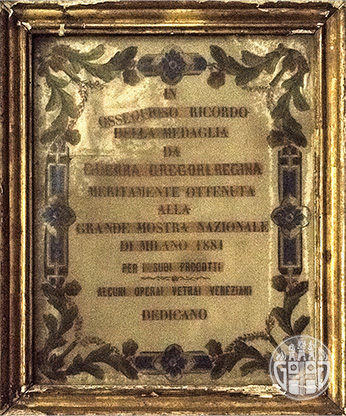
Medal awarded to Regina Guerra
The prestige of Fornace Guerra Gregorj expanded beyond the Veneto region and in 1881 it received official recognition for its products and in the same year a group of Venetian glass workers dedicated it to Regina "as a sign of obsequious remembrance for the medal deservedly obtained", a dedication framed with flowers with the predominant tone of blue, all composed of small glass balls.
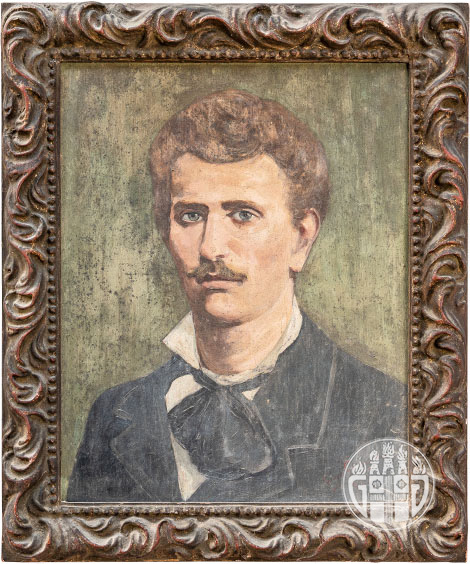
Gregorio Gregorj
Of the two sons, Gregorio had to give up his university studies in favor of Vincenzo, to manage the factory and become, as he said, a "humble kilnsman". He was struck by the various social ills of the area, such as the abandonment of minors and malnutrition and yet also constantly researching positivist thinking in the rural world, he wrote numerous books, including Cheap footwear for the poor classes, Treviso, Edizioni Agricultural Italy., The foundlings among the farmers of Veneto, Treviso, Ed Zoppelli, 1910.
A very important date for the furnace was 1887: the year of the fire of the factory and its material rebirth, through the reconstruction of the complex with an elegant and imposing neoclassical façade, unusual for a factory, beyond which there were new machinery and the new Hoffmann oven which allowed continuous cycle processing. Currently the neoclassical façade still has, although faded, the wording GUERRA-GREGORJ 1840-1887.
At the end of the nineteenth century, around one hundred workers worked in the furnace who lived in the 'workers' houses' specially built with rented agricultural land.
Married in 1975 to Laura Mandruzzato, with those good wishes which were not only represented by material gifts but also and no less important, poems, short greeting speeches framed by graceful flower arrangements. While Gregorio administered the factory, she proved to be a valid and faithful collaborator.
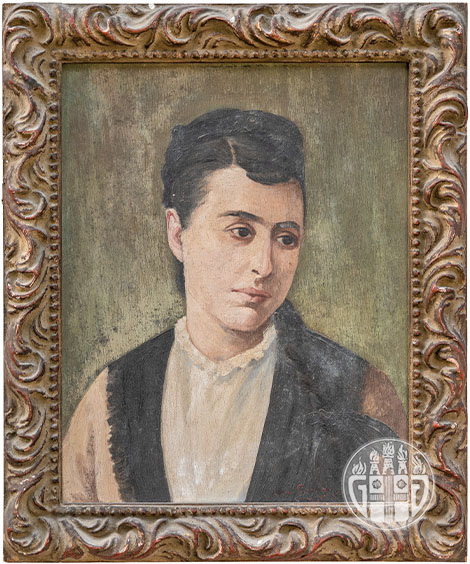
Laura Mandruzzato
The firing of bricks, which amounted to 3 million pieces per year, was accompanied by that of ceramics, for which the continuous cycle kiln represented a novelty at the time because there were only 3 or 4 in Italy.
With Gregorio, the production of artistic ceramics, which began in Regina's time, increased further, so much so that it led to national and European recognition.
In 1894 a patent was obtained for a special quality of repressed bricks which responded to the architectural needs of those times when particular bricks with bands and smooth edges were needed. The following year Gregorio obtained another patent for the creation of a special enamelled coloring of bricks called "a gran fire". Another patent was obtained by devising a technique that allowed the canvas of paintings to be simulated.
He did not limit himself to being an entrepreneur but also dedicated himself to social commitment, seeking all those positive ferments in the various aspects of society aimed at achieving results that could respond to the numerous and dramatic needs of the proletariat.
He was a member of the Progressive Party, as his forces were directed towards the realization of his ideals. Inside the factory he promoted a mutual aid society among the workers.
In 1898 Gregorio founded the Bulletin of the Bulletin of the Ceramic Industry, a very interesting publication of which he was also director and where news of events in the sector was given.
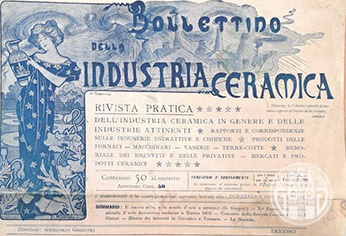
Header of the Ceramic Industry Bulletin
The header from the year 1901 with the frontispiece designed by Pietro Murani, depicts a girl intent on decorating a vase and surrounded by the image of the furnace in full activity.

Giorgio Gregorj
Mario Gregorj
Alfredo Gregorj
From 1913 to 1924 the management of the structure passed to his eldest son Giorgio, an engineer who graduated in the University of Padua. Recalling his university years, Giorgio often said that Gregorio did not want to pay for his second class train ticket but forced him to travel third class with the people.
In the meantime, his younger brother Mario attended the faculty of law in Padua with the intention of becoming a lawyer and then graduated on 23 November 1912 and can be seen in a poster that his classmates dedicated to him next to two books of the Civil Code and the Penal Code. Throughout his life he dedicated himself to painting and sculpture, specializing as an engraver of medals at the Mint of Rome.
In 1915 Giorgio gave orders to dismantle all the machinery and send them to Milan for fear of an Austrian invasion. The furnace was then occupied by the Italian army and production stopped. It resumed at full speed in 1919, the pavilions were enlarged, the electrical system was renewed and the acquisition of new machinery enriched the ceramic complex.
He took part in the expedition to help earthquake victims following a strong earthquake that struck Reggio and Messina on 28 December 1908. Giorgio became director of the works for the reconstruction of the town of Seminara di Palmi in Calabria, which concluded in June 1909. He was among the founders of the Cassa di Risparmio in 1913.
In the last free elections he was elected provincial deputy and, after the Liberation, he took part again in public life in Treviso as councilor for public works, and was mayor in 1951-52.
From 1924 his brother Alfredo managed the furnace, while continuing to collaborate with Giorgio to upgrade the buildings and build new houses for the workers, replacing the pre-existing ones and enlarging them. And in each of those houses there was a portico, a stable, those terracotta and brick floors also found in Petrarca's house in Arquà, giving the complex the appearance and function of a Venetian farmhouse, with solid brick walls and not drilled.
Alfredo followed the participation in the exhibitions. The one in 1925 was important, when a sample of decorated plates, statues and a ceramic fireplace with delicate circular ornaments in predominantly blue tones were exhibited. At the 1930 World Exhibition in Barcelona a gold medal was obtained with an impressive frieze with animals and a new style, modernism.
In 1962 Alfredo was President of the Industrial Association of the Province of Treviso and councilor at the Municipality of Treviso from 4 July 1956 to 6 December 1960 and from 20 June 1951 to 4 July 1956.
Following the difficulties of the war, the furnace no longer conformed to the times and the new dynamics of development. The products, despite being of excellent quality, had production costs no longer in line with the market. The company would have required significant financial commitments to completely renew the machinery, which was not possible. The factory had to close down in 1965.
